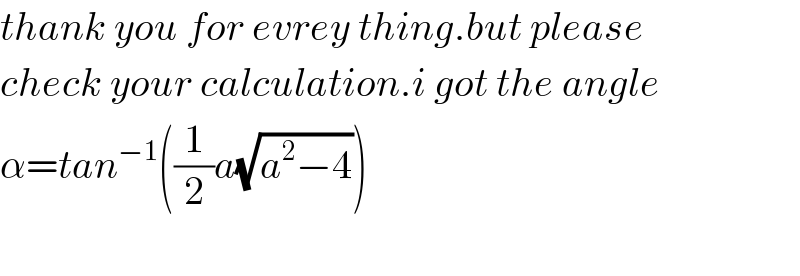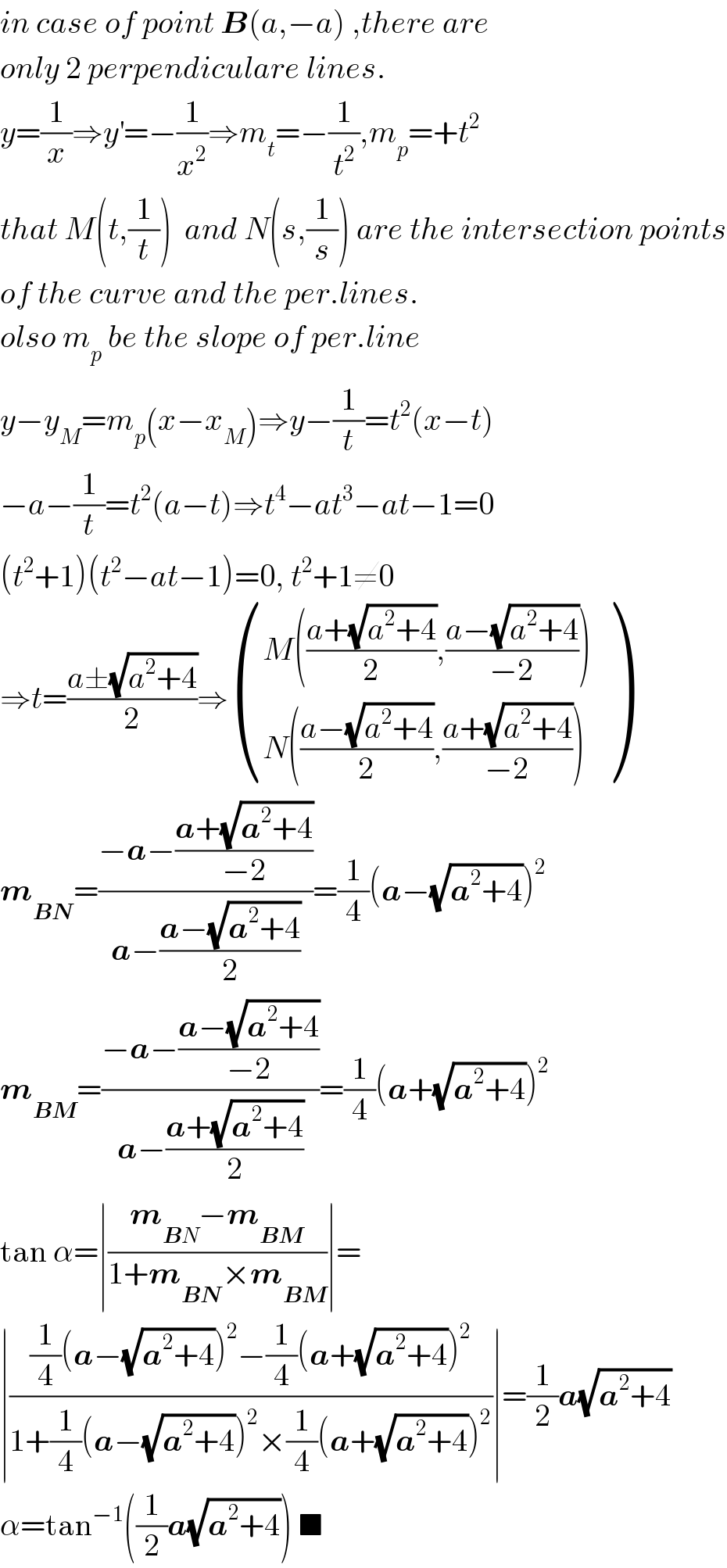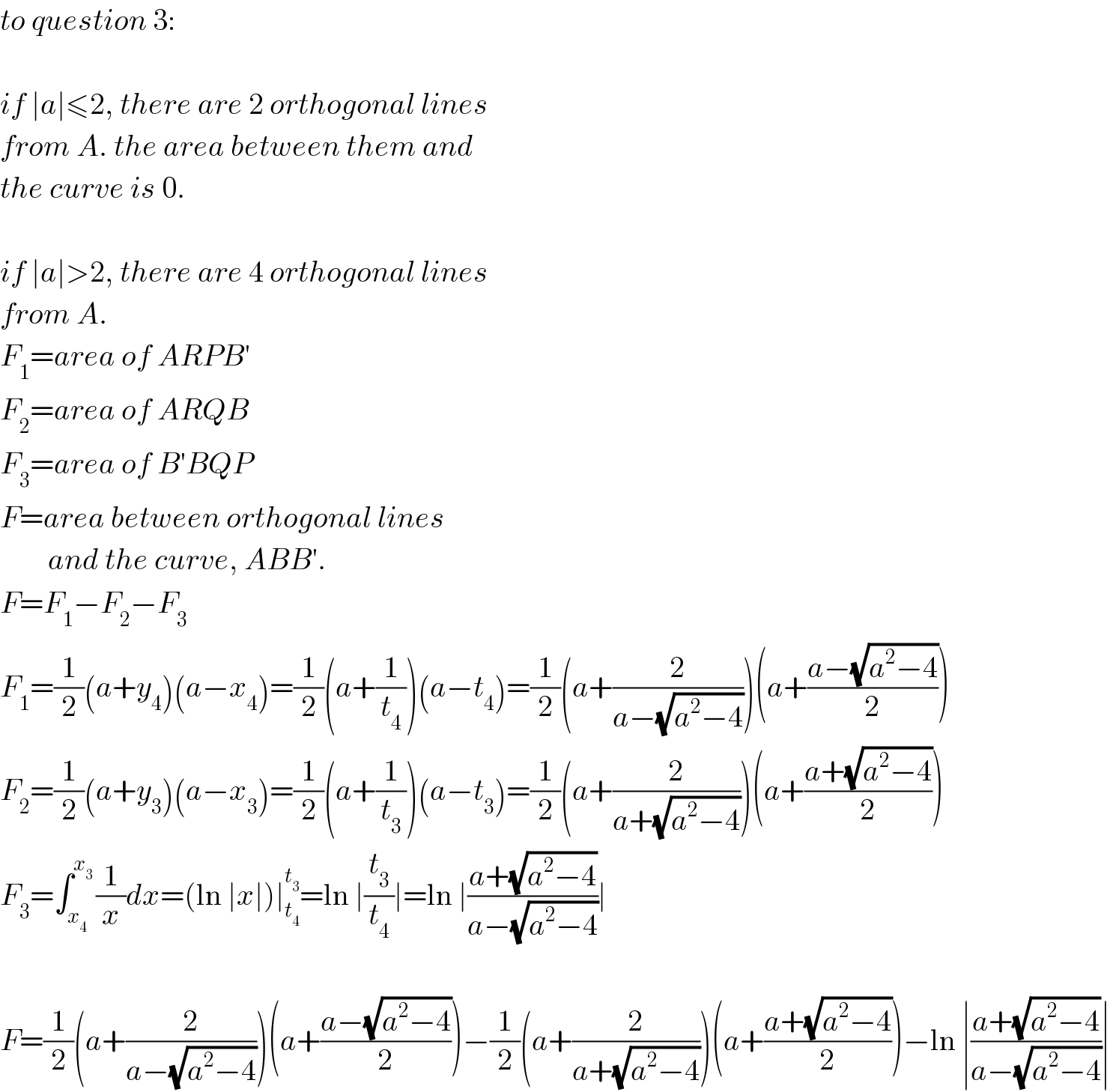
Question Number 10223 by amir last updated on 30/Jan/17

Answered by mrW1 last updated on 03/Feb/17

$${to}\:{question}\:\mathrm{1}: \\ $$$$ \\ $$$${xy}=\mathrm{1} \\ $$$${y}=\frac{\mathrm{1}}{{x}} \\ $$$${y}'=−\frac{\mathrm{1}}{{x}^{\mathrm{2}} } \\ $$$${let}\:{B}\:{a}\:{point}\:{on}\:{the}\:{curve}\:{and}\:{AB}\:{is} \\ $$$${a}\:{orthogonal}\:{line}\:{to}\:{the}\:{curve}. \\ $$$${let}\:{point}\:{B}\:{have}\:{the}\:{coordinates}\:\left({t},\:{s}\right). \\ $$$${s}=\frac{\mathrm{1}}{{t}} \\ $$$$ \\ $$$${the}\:{slope}\:{of}\:{tangent}\:{line}\:{on}\:{point}\:{B}: \\ $$$${m}_{{t}} ={y}'\left({t}\right)=−\frac{\mathrm{1}}{{t}^{\mathrm{2}} } \\ $$$$ \\ $$$${the}\:{slope}\:{of}\:{the}\:{orthogonal}\:{line}: \\ $$$${m}_{{o}} =−\frac{\mathrm{1}}{{m}_{{t}} }={t}^{\mathrm{2}} \\ $$$$ \\ $$$${the}\:{equation}\:{of}\:{the}\:{orthogonal}\:{line}: \\ $$$${y}−{s}={m}_{{o}} \left({x}−{t}\right) \\ $$$${y}−\frac{\mathrm{1}}{{t}}={t}^{\mathrm{2}} \left({x}−{t}\right) \\ $$$$ \\ $$$${since}\:{A}\left({a},{a}\right)\:{is}\:{a}\:{point}\:{on}\:{it},\:{we}\:{get} \\ $$$${a}−\frac{\mathrm{1}}{{t}}={t}^{\mathrm{2}} \left({a}−{t}\right) \\ $$$${t}^{\mathrm{4}} −{at}^{\mathrm{3}} +{at}−\mathrm{1}=\mathrm{0} \\ $$$$\left({t}+\mathrm{1}\right)\left({t}−\mathrm{1}\right)\left({t}^{\mathrm{2}} −{at}+\mathrm{1}\right)=\mathrm{0} \\ $$$$\Rightarrow{t}_{\mathrm{1}} =−\mathrm{1}\:\left({point}\:{D}\right)\:{or} \\ $$$$\Rightarrow{t}_{\mathrm{2}} =\mathrm{1}\:\left({point}\:{C}\right)\:{or} \\ $$$$\Rightarrow{t}−{at}+\mathrm{1}=\mathrm{0} \\ $$$$\Rightarrow\Rightarrow{t}_{\mathrm{3},\mathrm{4}} =\frac{{a}\pm\sqrt{{a}^{\mathrm{2}} −\mathrm{4}}}{\mathrm{2}} \\ $$$${if}\:\mid{a}\mid<\mathrm{2},\:{t}_{\mathrm{3},\mathrm{4}} \:={unreal} \\ $$$${if}\:\mid{a}\mid=\mathrm{2},\:{t}_{\mathrm{3},\mathrm{4}} \:=\mathrm{1}={t}_{\mathrm{2}} \\ $$$${if}\:\mid{a}\mid>\mathrm{2},\:{t}_{\mathrm{3},\mathrm{4}} \:=\frac{{a}\pm\sqrt{{a}^{\mathrm{2}} −\mathrm{4}}}{\mathrm{2}}\:\left({point}\:{B}\:{and}\:{B}'\right) \\ $$$$ \\ $$$${i}.{e}.\:{for}\:{any}\:{point}\:{A}\left({a},{a}\right)\:{there}\:{are} \\ $$$${at}\:{least}\:\mathrm{2}\:{orthogonal}\:{lines}\:\left({AC},\:{AD}\right). \\ $$$${if}\:\mid{a}\mid>\mathrm{2},\:{there}\:{are}\:{even}\:\mathrm{2}\:{additional} \\ $$$${orthogonal}\:{lines}\:\left({AB},{AB}'\right). \\ $$$$ \\ $$$$ \\ $$
Commented by mrW1 last updated on 02/Feb/17

Commented by amir last updated on 02/Feb/17

$${thank}\:{you}\:{so}\:{much}.{but}\:{Q}\:{no}.\mathrm{2}\:{and}\:{no}.\mathrm{3}\:? \\ $$
Commented by amir last updated on 02/Feb/17

$${with}\:{which}\:{program}\:{i}\:{can}\:{draw}\:{this}\:\: \\ $$$${diagrams}? \\ $$
Commented by mrW1 last updated on 03/Feb/17

$${please}\:{try}\:{the}\:{app}\:{geogebra}. \\ $$
Answered by mrW1 last updated on 04/Feb/17

$${to}\:{question}\:\mathrm{2}: \\ $$$$ \\ $$$${if}\:\mid{a}\mid\leqslant\mathrm{2},\:{i}.{e}.\:−\mathrm{2}\leqslant{a}\leqslant\mathrm{2},\:{there}\:{are}\:{only} \\ $$$$\mathrm{2}\:{orthogonal}\:{lines}\:{from}\:{point}\:{A}: \\ $$$${AD}\:{with}\:{slope}\:=\:\mathrm{45}° \\ $$$${AC}\:{with}\:{slope}\:=\:\mathrm{45}° \\ $$$${the}\:{angel}\:{between}\:{them}\:{is}\:\mathrm{0}°. \\ $$$$ \\ $$$${if}\:\mid{a}\mid>\mathrm{2},\:{i}.{e}.\:{a}<−\mathrm{2}\:{or}\:{a}>\mathrm{2},\:{there}\:{are} \\ $$$$\mathrm{4}\:{orthogonal}\:{lines}\:{from}\:{point}\:{A}: \\ $$$${AD}\:{with}\:{slope}\:=\:\mathrm{45}° \\ $$$${AC}\:{with}\:{slope}\:=\:\mathrm{45}° \\ $$$${the}\:{angel}\:{between}\:{them}\:{is}\:\mathrm{0}°. \\ $$$${AB}\:{with}\:{slope}\:{angel},\:{lets}\:{say}\:\alpha_{\mathrm{1}} \\ $$$${AB}'\:{with}\:{slope}\:{angel},\:{lets}\:{say}\:\alpha_{\mathrm{2}} \\ $$$${the}\:{angel}\:{between}\:{them}\:{is},\:{lets}\:{say}\:\alpha \\ $$$$\alpha=\alpha_{\mathrm{1}} −\alpha_{\mathrm{2}} \\ $$$$\mathrm{tan}\:\alpha_{\mathrm{1}} =−\frac{\mathrm{1}}{{f}'\left({t}_{\mathrm{3}} \right)}={t}_{\mathrm{3}} ^{\mathrm{2}} =\left(\frac{{a}+\sqrt{{a}^{\mathrm{2}} −\mathrm{4}}}{\mathrm{2}}\right)^{\mathrm{2}} \\ $$$$\mathrm{tan}\:\alpha_{\mathrm{2}} =−\frac{\mathrm{1}}{{f}'\left({t}_{\mathrm{4}} \right)}={t}_{\mathrm{4}} ^{\mathrm{2}} =\left(\frac{{a}−\sqrt{{a}^{\mathrm{2}} −\mathrm{4}}}{\mathrm{2}}\right)^{\mathrm{2}} \\ $$$$\mathrm{tan}\:\alpha=\mathrm{tan}\:\left(\alpha_{\mathrm{1}} −\alpha_{\mathrm{2}} \right)=\frac{\mathrm{tan}\:\alpha_{\mathrm{1}} −\mathrm{tan}\:\alpha_{\mathrm{2}} }{\mathrm{1}+\mathrm{tan}\:_{\mathrm{1}} \mathrm{tan}\:\alpha_{\mathrm{2}} } \\ $$$$=\frac{\left(\frac{{a}+\sqrt{{a}^{\mathrm{2}} −\mathrm{4}}}{\mathrm{2}}\right)^{\mathrm{2}} −\left(\frac{{a}−\sqrt{{a}^{\mathrm{2}} −\mathrm{4}}}{\mathrm{2}}\right)^{\mathrm{2}} }{\mathrm{1}+\left(\frac{{a}+\sqrt{{a}^{\mathrm{2}} −\mathrm{4}}}{\mathrm{2}}\right)^{\mathrm{2}} \left(\frac{{a}−\sqrt{{a}^{\mathrm{2}} −\mathrm{4}}}{\mathrm{2}}\right)^{\mathrm{2}} } \\ $$$$=\mathrm{4}×\frac{\left({a}+\sqrt{{a}^{\mathrm{2}} −\mathrm{4}}\right)^{\mathrm{2}} −\left({a}−\sqrt{{a}^{\mathrm{2}} −\mathrm{4}}\right)^{\mathrm{2}} }{\mathrm{16}+\left({a}+\sqrt{{a}^{\mathrm{2}} −\mathrm{4}}\right)^{\mathrm{2}} \left({a}−\sqrt{{a}^{\mathrm{2}} −\mathrm{4}}\right)^{\mathrm{2}} }\: \\ $$$$=\mathrm{4}×\frac{\left({a}+\sqrt{{a}^{\mathrm{2}} −\mathrm{4}}+{a}−\sqrt{{a}^{\mathrm{2}} −\mathrm{4}}\right)\left({a}+\sqrt{{a}^{\mathrm{2}} −\mathrm{4}}−{a}+\sqrt{{a}^{\mathrm{2}} −\mathrm{4}}\right)}{\mathrm{16}+\left({a}^{\mathrm{2}} −{a}^{\mathrm{2}} +\mathrm{4}\right)^{\mathrm{2}} } \\ $$$$=\mathrm{4}×\frac{\left(\mathrm{2}{a}\right)\left(\mathrm{2}\sqrt{{a}^{\mathrm{2}} −\mathrm{4}}\right)}{\mathrm{32}} \\ $$$$=\frac{{a}\sqrt{{a}^{\mathrm{2}} −\mathrm{4}}}{\mathrm{2}} \\ $$$$\alpha=\mathrm{tan}^{−\mathrm{1}} \left(\frac{{a}\sqrt{{a}^{\mathrm{2}} −\mathrm{4}}}{\mathrm{2}}\right) \\ $$
Commented by amir last updated on 04/Feb/17

$${thank}\:{you}\:{for}\:{evrey}\:{thing}.{but}\:{please} \\ $$$${check}\:{your}\:{calculation}.{i}\:{got}\:{the}\:{angle} \\ $$$$\alpha={tan}^{−\mathrm{1}} \left(\frac{\mathrm{1}}{\mathrm{2}}{a}\sqrt{{a}^{\mathrm{2}} −\mathrm{4}}\right) \\ $$$$ \\ $$
Commented by mrW1 last updated on 04/Feb/17

$${your}\:{are}\:{right}.\:{it}\:{is}\:{fixed}\:{now}.\:{thank}\:{you}! \\ $$
Commented by mrW1 last updated on 04/Feb/17

$${what}\:{about}\:{Q}\mathrm{1}\:{and}\:{Q}\mathrm{2}\:{if}\:{we}\:{have}\:{point}\:{A}\left({a},−{a}\right)? \\ $$
Commented by amir last updated on 08/Feb/17

$${in}\:{case}\:{of}\:{point}\:\boldsymbol{{B}}\left({a},−{a}\right)\:,{there}\:{are} \\ $$$${only}\:\mathrm{2}\:{perpendiculare}\:{lines}. \\ $$$${y}=\frac{\mathrm{1}}{{x}}\Rightarrow{y}^{'} =−\frac{\mathrm{1}}{{x}^{\mathrm{2}} }\Rightarrow{m}_{{t}} =−\frac{\mathrm{1}}{{t}^{\mathrm{2}} },{m}_{{p}} =+{t}^{\mathrm{2}} \\ $$$${that}\:{M}\left({t},\frac{\mathrm{1}}{{t}}\right)\:\:{and}\:{N}\left({s},\frac{\mathrm{1}}{{s}}\right)\:{are}\:{the}\:{intersection}\:{points} \\ $$$${of}\:{the}\:{curve}\:{and}\:{the}\:{per}.{lines}. \\ $$$${olso}\:{m}_{{p}} \:{be}\:{the}\:{slope}\:{of}\:{pe}\underset{} {{r}}.{line} \\ $$$${y}−{y}_{{M}} ={m}_{{p}} \left({x}−{x}_{{M}} \right)\Rightarrow{y}−\frac{\mathrm{1}}{{t}}={t}^{\mathrm{2}} \left({x}−{t}\right) \\ $$$$−{a}−\frac{\mathrm{1}}{{t}}={t}^{\mathrm{2}} \left({a}−{t}\right)\Rightarrow{t}^{\mathrm{4}} −{at}^{\mathrm{3}} −{at}−\mathrm{1}=\mathrm{0} \\ $$$$\left({t}^{\mathrm{2}} +\mathrm{1}\right)\left({t}^{\mathrm{2}} −{at}−\mathrm{1}\right)=\mathrm{0},\:{t}^{\mathrm{2}} +\mathrm{1}\neq\mathrm{0} \\ $$$$\Rightarrow{t}=\frac{{a}\pm\sqrt{{a}^{\mathrm{2}} +\mathrm{4}}}{\mathrm{2}}\Rightarrow\begin{pmatrix}{{M}\left(\frac{{a}+\sqrt{{a}^{\mathrm{2}} +\mathrm{4}}}{\mathrm{2}},\frac{{a}−\sqrt{{a}^{\mathrm{2}} +\mathrm{4}}}{−\mathrm{2}}\right)}\\{{N}\left(\frac{{a}−\sqrt{{a}^{\mathrm{2}} +\mathrm{4}}}{\mathrm{2}},\frac{{a}+\sqrt{{a}^{\mathrm{2}} +\mathrm{4}}}{−\mathrm{2}}\right)}\end{pmatrix} \\ $$$$\boldsymbol{{m}}_{\boldsymbol{{BN}}} =\frac{−\boldsymbol{{a}}−\frac{\boldsymbol{{a}}+\sqrt{\boldsymbol{{a}}^{\mathrm{2}} +\mathrm{4}}}{−\mathrm{2}}}{\boldsymbol{{a}}−\frac{\boldsymbol{{a}}−\sqrt{\boldsymbol{{a}}^{\mathrm{2}} +\mathrm{4}}}{\mathrm{2}}}=\frac{\mathrm{1}}{\mathrm{4}}\left(\boldsymbol{{a}}−\sqrt{\boldsymbol{{a}}^{\mathrm{2}} +\mathrm{4}}\right)^{\mathrm{2}} \\ $$$$\boldsymbol{{m}}_{\boldsymbol{{BM}}} =\frac{−\boldsymbol{{a}}−\frac{\boldsymbol{{a}}−\sqrt{\boldsymbol{{a}}^{\mathrm{2}} +\mathrm{4}}}{−\mathrm{2}}}{\boldsymbol{{a}}−\frac{\boldsymbol{{a}}+\sqrt{\boldsymbol{{a}}^{\mathrm{2}} +\mathrm{4}}}{\mathrm{2}}}=\frac{\mathrm{1}}{\mathrm{4}}\left(\boldsymbol{{a}}+\sqrt{\boldsymbol{{a}}^{\mathrm{2}} +\mathrm{4}}\right)^{\mathrm{2}} \\ $$$$\mathrm{tan}\:\alpha=\mid\frac{\boldsymbol{{m}}_{\boldsymbol{{B}}{N}} −\boldsymbol{{m}}_{\boldsymbol{{BM}}} }{\mathrm{1}+\boldsymbol{{m}}_{\boldsymbol{{BN}}} ×\boldsymbol{{m}}_{\boldsymbol{{BM}}} }\mid= \\ $$$$\mid\frac{\frac{\mathrm{1}}{\mathrm{4}}\left(\boldsymbol{{a}}−\sqrt{\boldsymbol{{a}}^{\mathrm{2}} +\mathrm{4}}\right)^{\mathrm{2}} −\frac{\mathrm{1}}{\mathrm{4}}\left(\boldsymbol{{a}}+\sqrt{\boldsymbol{{a}}^{\mathrm{2}} +\mathrm{4}}\right)^{\mathrm{2}} }{\mathrm{1}+\frac{\mathrm{1}}{\mathrm{4}}\left(\boldsymbol{{a}}−\sqrt{\boldsymbol{{a}}^{\mathrm{2}} +\mathrm{4}}\right)^{\mathrm{2}} ×\frac{\mathrm{1}}{\mathrm{4}}\left(\boldsymbol{{a}}+\sqrt{\boldsymbol{{a}}^{\mathrm{2}} +\mathrm{4}}\right)^{\mathrm{2}} }\mid=\frac{\mathrm{1}}{\mathrm{2}}\boldsymbol{{a}}\sqrt{\boldsymbol{{a}}^{\mathrm{2}} +\mathrm{4}} \\ $$$$\alpha=\mathrm{tan}^{−\mathrm{1}} \left(\frac{\mathrm{1}}{\mathrm{2}}\boldsymbol{{a}}\sqrt{\boldsymbol{{a}}^{\mathrm{2}} +\mathrm{4}}\right)\:\blacksquare \\ $$
Commented by amir last updated on 07/Feb/17

Commented by amir last updated on 07/Feb/17

$${dear}\:{mrW}\mathrm{1}!\:{please}\:{draw}\:{a}\:{nice}\:{diagram} \\ $$$${with}\:{geogebra}\:{and}\:{post}\:{it}\:{here}.{tnx}. \\ $$
Commented by mrW1 last updated on 08/Feb/17

Commented by amir last updated on 08/Feb/17

$${thank}\:{you}\:{very}\:{much}\:{mrw}\mathrm{1}. \\ $$$${you}\:{are}\:{a}\:{real}\:{mathmatic}\:{man}. \\ $$$${goodlock}! \\ $$
Answered by mrW1 last updated on 03/Feb/17

$${to}\:{question}\:\mathrm{3}: \\ $$$$ \\ $$$${if}\:\mid{a}\mid\leqslant\mathrm{2},\:{there}\:{are}\:\mathrm{2}\:{orthogonal}\:{lines} \\ $$$${from}\:{A}.\:{the}\:{area}\:{between}\:{them}\:{and} \\ $$$${the}\:{curve}\:{is}\:\mathrm{0}. \\ $$$$ \\ $$$${if}\:\mid{a}\mid>\mathrm{2},\:{there}\:{are}\:\mathrm{4}\:{orthogonal}\:{lines} \\ $$$${from}\:{A}. \\ $$$${F}_{\mathrm{1}} ={area}\:{of}\:{ARPB}' \\ $$$${F}_{\mathrm{2}} ={area}\:{of}\:{ARQB} \\ $$$${F}_{\mathrm{3}} ={area}\:{of}\:{B}'{BQP} \\ $$$${F}={area}\:{between}\:{orthogonal}\:{lines}\: \\ $$$$\:\:\:\:\:\:\:\:{and}\:{the}\:{curve},\:{ABB}'. \\ $$$${F}={F}_{\mathrm{1}} −{F}_{\mathrm{2}} −{F}_{\mathrm{3}} \\ $$$${F}_{\mathrm{1}} =\frac{\mathrm{1}}{\mathrm{2}}\left({a}+{y}_{\mathrm{4}} \right)\left({a}−{x}_{\mathrm{4}} \right)=\frac{\mathrm{1}}{\mathrm{2}}\left({a}+\frac{\mathrm{1}}{{t}_{\mathrm{4}} }\right)\left({a}−{t}_{\mathrm{4}} \right)=\frac{\mathrm{1}}{\mathrm{2}}\left({a}+\frac{\mathrm{2}}{{a}−\sqrt{{a}^{\mathrm{2}} −\mathrm{4}}}\right)\left({a}+\frac{{a}−\sqrt{{a}^{\mathrm{2}} −\mathrm{4}}}{\mathrm{2}}\right) \\ $$$${F}_{\mathrm{2}} =\frac{\mathrm{1}}{\mathrm{2}}\left({a}+{y}_{\mathrm{3}} \right)\left({a}−{x}_{\mathrm{3}} \right)=\frac{\mathrm{1}}{\mathrm{2}}\left({a}+\frac{\mathrm{1}}{{t}_{\mathrm{3}} }\right)\left({a}−{t}_{\mathrm{3}} \right)=\frac{\mathrm{1}}{\mathrm{2}}\left({a}+\frac{\mathrm{2}}{{a}+\sqrt{{a}^{\mathrm{2}} −\mathrm{4}}}\right)\left({a}+\frac{{a}+\sqrt{{a}^{\mathrm{2}} −\mathrm{4}}}{\mathrm{2}}\right) \\ $$$${F}_{\mathrm{3}} =\int_{{x}_{\mathrm{4}} \:} ^{{x}_{\mathrm{3}} } \frac{\mathrm{1}}{{x}}{dx}=\left(\mathrm{ln}\:\mid{x}\mid\right)\mid_{{t}_{\mathrm{4}} } ^{{t}_{\mathrm{3}} } =\mathrm{ln}\:\mid\frac{{t}_{\mathrm{3}} }{{t}_{\mathrm{4}} }\mid=\mathrm{ln}\:\mid\frac{{a}+\sqrt{{a}^{\mathrm{2}} −\mathrm{4}}}{{a}−\sqrt{{a}^{\mathrm{2}} −\mathrm{4}}}\mid \\ $$$$ \\ $$$${F}=\frac{\mathrm{1}}{\mathrm{2}}\left({a}+\frac{\mathrm{2}}{{a}−\sqrt{{a}^{\mathrm{2}} −\mathrm{4}}}\right)\left({a}+\frac{{a}−\sqrt{{a}^{\mathrm{2}} −\mathrm{4}}}{\mathrm{2}}\right)−\frac{\mathrm{1}}{\mathrm{2}}\left({a}+\frac{\mathrm{2}}{{a}+\sqrt{{a}^{\mathrm{2}} −\mathrm{4}}}\right)\left({a}+\frac{{a}+\sqrt{{a}^{\mathrm{2}} −\mathrm{4}}}{\mathrm{2}}\right)−\mathrm{ln}\:\mid\frac{{a}+\sqrt{{a}^{\mathrm{2}} −\mathrm{4}}}{{a}−\sqrt{{a}^{\mathrm{2}} −\mathrm{4}}}\mid \\ $$
